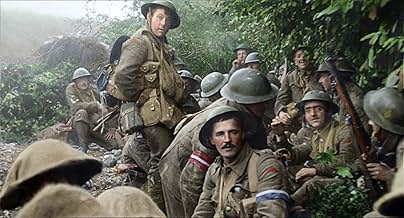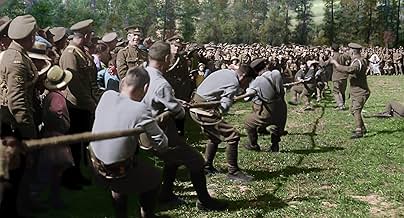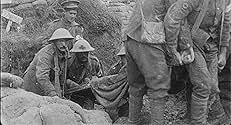VALUTAZIONE IMDb
8,2/10
39.921
LA TUA VALUTAZIONE
Un documentario sulla prima guerra mondiale con dei filmati mai visti prima per commemorare il centenario della fine della guerra.Un documentario sulla prima guerra mondiale con dei filmati mai visti prima per commemorare il centenario della fine della guerra.Un documentario sulla prima guerra mondiale con dei filmati mai visti prima per commemorare il centenario della fine della guerra.
- Nominato ai 1 BAFTA Award
- 6 vittorie e 14 candidature totali
Thomas Adlam
- Self - Bedfordshire Regiment
- (voce)
- (as Capt Thomas Adlam VC)
William Argent
- Self - Royal Naval Air Service
- (voce)
- (as LM William Argent)
John Ashby
- Self - The Duke of Cambridge's Own (Middlesex Regiment)
- (voce)
- (as Cpl John Ashby)
Attwood
- Self - British Army
- (voce)
- (as Cpl Attwood)
Walter Aust
- Self - East Yorkshire Regiment
- (voce)
- (as Pte Walter Aust)
Donald Bain
- Self - Seaforth Highlanders
- (voce)
- (as Pte Donald Bain)
Thomas Baker
- Self - Chatham Battalion, Royal Naval Division
- (voce)
- (as Pte Thomas Baker)
George Banton
- Self - 50th Division Headquarters
- (voce)
- (as Sig George Banton)
Walter Becklake
- Self - Northhampyonshire Yeomanry
- (voce)
- (as L Cpl Walter Becklake MM)
Arthur Beeton
- Self - Royal Navy Air Service
- (voce)
- (as POM Arthur Beeton)
Robert Bell
- Self - British Army
- (voce)
- (as Mr Robert Bell)
William Benham
- Self - Hawke Battalion, Royal Navy Division
- (voce)
- (as Sub Lt William Benham)
Joseph Biglin
- Self - Durham Light Infantry
- (voce)
- (as Pte Joseph Biglin)
Edwin Bigwood
- Self - Worcestershire Regiment
- (voce)
- (as Pte Edwin Bigwood)
Horace Birks
- Self - Tanks Corps
- (voce)
- (as Capt Horace Birks)
Edmund Blunden
- Self - Royal Sussex Regiment
- (voce)
- (as Lt Edmund Blunden MC)
Clarence Bourne
- Self - Army Service Corps
- (voce)
- (as S Sgt Clarence Bourne)
Allan Bray
- Self - The Duke of Edinburgh's ((Whiltshire Regiment))
- (voce)
- (as L Cpl Allan Bray)
Recensioni in evidenza
"Trapped in a Charlie Chaplin World". So says director Peter Jackson in a post-screening discussion with Mark Kermode, describing early black and white documentary footage. Whereas modern film runs at 24 fps, most of the old footage is hand cranked, with speeds as low as 12 fps which leads to its jerky nature. Jackson in this project with the Imperial War Museum took their WW1 footage and put it through a 'pipeline process. This cleaned-up and restored the original footage; used clever computer interpolation to add in the missing 6 to 12 frames per second; and then colourised it.
The results are outstanding. Jackson wisely focuses the film on the specific slice of WW1 action from the trenches. And those anonymous figures become real, live, breathing humans on screen. It is obviously tragic that some (and as commented by Jackson, many in one scene) are not to be breathing humans for much longer.
These effects take a while to kick in. The early scenes in the documentary are in the original black and white, describing the recruitment process, and how many of the recruits were under-age. (To explain the varied comments in the film, they should have been 18, although officially shouldn't have been sent overseas until 19).
It is when the troops arrive in France that we suddenly go from black-and-white to the fully restored and colourised footage, and it is a gasp-inducing moment.
All of the audio commentary is from original BBC recordings of war veterans recounting their actual experiences in the trench. Some sound like heroes; some sound like rogues; all came out changed men. Supporting music of WW1 ditties, including the incredibly rude "Mademoiselle from Armentières" over the end credits, is provided by Plan 9.
But equally impressive is the dubbing of the characters onscreen. Jackson employed forensic lip-readers to determine what the soldiers on-screen were saying, and reproduced the speech using appropriate regional accents for the regiments concerned. Jackson also recounts how the words associated with a "pep-talk" speech to troops by an officer he found on an original slip of paper within the regimental records: outstanding. Added sound effects include real-life shelling by the New Zealand army. It all adds to the overall atmosphere of the film.
The film itself is a masterpiece of technical innovation that will change in the future the way in which we should be able to see this sort of early film footage forever. As a documentary it's near-perfection. But if I have a criticism of the cinema showing I attended it is that the 3D tended to detract rather than add to the film. Perhaps this is just my eyesight, but 3D always tends to make images slightly more blurry. Where (like "Gravity") there are great 3D effects to showcase, it's worth the slight negative to get the massive positive. But here, there was no such benefit: 2D would have been better. For those in the UK (and possibly through other broadcasters worldwide) the film is being shown on BBC2 tonight (11/11/18) at 9:30: I will be watching it again to compare and contrast.
Jackson dedicated the film to his grandfather. And almost all of us Brits will have relatives affected by this "war to end all wars". In my case, my grandfather was shot and severely wounded at Leuze Wood on the Somme, lying in the mud for four days and four nights before being recovered... by the Germans! Fortunately he was well-treated and, although dying young, recovered enough to father my father - else I wouldn't be here today writing this. On this Rememberance Sunday, 100 years on, it is a time for us to truly remember the sacrifice these men and boys gave to what, all in the film agree, was a pretty obstinate and pointless conflict.
The results are outstanding. Jackson wisely focuses the film on the specific slice of WW1 action from the trenches. And those anonymous figures become real, live, breathing humans on screen. It is obviously tragic that some (and as commented by Jackson, many in one scene) are not to be breathing humans for much longer.
These effects take a while to kick in. The early scenes in the documentary are in the original black and white, describing the recruitment process, and how many of the recruits were under-age. (To explain the varied comments in the film, they should have been 18, although officially shouldn't have been sent overseas until 19).
It is when the troops arrive in France that we suddenly go from black-and-white to the fully restored and colourised footage, and it is a gasp-inducing moment.
All of the audio commentary is from original BBC recordings of war veterans recounting their actual experiences in the trench. Some sound like heroes; some sound like rogues; all came out changed men. Supporting music of WW1 ditties, including the incredibly rude "Mademoiselle from Armentières" over the end credits, is provided by Plan 9.
But equally impressive is the dubbing of the characters onscreen. Jackson employed forensic lip-readers to determine what the soldiers on-screen were saying, and reproduced the speech using appropriate regional accents for the regiments concerned. Jackson also recounts how the words associated with a "pep-talk" speech to troops by an officer he found on an original slip of paper within the regimental records: outstanding. Added sound effects include real-life shelling by the New Zealand army. It all adds to the overall atmosphere of the film.
The film itself is a masterpiece of technical innovation that will change in the future the way in which we should be able to see this sort of early film footage forever. As a documentary it's near-perfection. But if I have a criticism of the cinema showing I attended it is that the 3D tended to detract rather than add to the film. Perhaps this is just my eyesight, but 3D always tends to make images slightly more blurry. Where (like "Gravity") there are great 3D effects to showcase, it's worth the slight negative to get the massive positive. But here, there was no such benefit: 2D would have been better. For those in the UK (and possibly through other broadcasters worldwide) the film is being shown on BBC2 tonight (11/11/18) at 9:30: I will be watching it again to compare and contrast.
Jackson dedicated the film to his grandfather. And almost all of us Brits will have relatives affected by this "war to end all wars". In my case, my grandfather was shot and severely wounded at Leuze Wood on the Somme, lying in the mud for four days and four nights before being recovered... by the Germans! Fortunately he was well-treated and, although dying young, recovered enough to father my father - else I wouldn't be here today writing this. On this Rememberance Sunday, 100 years on, it is a time for us to truly remember the sacrifice these men and boys gave to what, all in the film agree, was a pretty obstinate and pointless conflict.
Utterly haunting movie of life on the western front in WW1. Peter Jackson has thrown some serious computer firepower to bring these soldiers back to life.You will have never seen anything quite like this before.Breathtaking in many parts!
10mattwidd
I was lucky enough to bag a ticket to the one off showing of Peter Jackson's They Shall Not Grow Old, having watched a lot of World War One documentaries and made countless visits to historic sites across France and Belgium I was keen to see what was being marketed as a 'new' perspective on The Great War, it did not disappoint.
Jackson chose to create a narrow focus narrative for this 1 hour 30 minute documentary to allow the viewer to delve into the fine details often missed in more sweeping documentaries trying to cover all aspects and areas of the conflict. Jackson chose to look closely at the lives and experiences of British native frontline troops in Belgium. The documentary follows a linear timeline beginning with the breakout of war and the initial volunteering of thousands of young men excited and ready for an adventure for King and Country and ends with the great sense of loss and uncertainty of the future the troops had by the end of the war.
The entire documentary is narrated by records of surviving troops recorded in the 60s and 70s, this was an intentional move by Jackson that definitely adds to the ability for the viewer to connect and relate to the survivors.
I especially found the stories and anecdotes about the goings on behind the lines during down time and R&R for the troops captivating as it is often over looked in other documentaries solely concentrating on the combat and horrors of war.
The pain staking effort and lengths Jackson and his team went to to restore this footage not only with colour but with frame rate, sharpness and especially sound is breath taking. Taking the time to have professional lip readers painstakingly review all the footage so allow us to then know and hear what was being said truly brought the footage to life.
My only issue with the film, something that is made note of by Jackson is of course because of the time in history and available cameras there is no actual combat footage available so you do spend a large amount of time just watching still hand drawn cartoons of the battles from the time, something that cannot be avoided but does detract from the immersion the rest of the film creates.
I highly recommend this film to everyone, it is important we see the true perspective of what our ancestors went through and never forget these brave men and women.
As this historically important anniversary draws to a close, I just want to say that my viewing of this film was that of utter amazement. As a photo colouriser/restorer, I was absolutely astonished at the work PJ's team put into this. The transition from the original film material, then to the stabilised and corrected FPS and then the full colour and sound was one of the most spectacular things I have ever seen on the screen. The colour is natural and really helps emphasise the grittiness of war and brings out hidden details that may have been missed in the B&W source. Usually I prefer film not to be tampered with, but as Jackson says, this is how the men saw it - in living colour. The addition of the voiceovers from the surviving soldiers themselves is a great choice and doesn't distract and flows along nicely with the visuals. Throughout I expressed various emotions of sadness and shock, but surprisingly a few laughs, particularly one shot showing a soldier banging a tune on another soldiers helmet as they march.
I do wish I had seen this on the big screen and I imagine what I have said is enhanced 100x more with that type of viewing. A fitting tribute to the men that did and didn't come home and I hope it is recognised and picks up many awards.
Everyone over the age of 13 should be made to watch this.
This is simple exceptional work at every level from Peter Jackson and his team.
It showed the pure fragility of life, and how the soldiers dealt with it, mainly with humour and machine gun boiled tea.
It's haunting yet funny, disturbing yet uplifting. It's war. And this is the closest I ever want to come to it.
This is simple exceptional work at every level from Peter Jackson and his team.
It showed the pure fragility of life, and how the soldiers dealt with it, mainly with humour and machine gun boiled tea.
It's haunting yet funny, disturbing yet uplifting. It's war. And this is the closest I ever want to come to it.
Lo sapevi?
- QuizMuch of the footage had never been seen, having sat in the vaults of London's Imperial War Museum for many years.
- BlooperSeveral shots of tanks appear in the film, both Mark V (Mark Five) and Mark V* (Mark Five Star). They have been colourised green. In reality, tanks of these types were painted "a neutral brown colour". See the article by the British Tank Museum which states that. "Surrendering to the inevitable, towards the end of 1916 it was ordered that the tanks should be painted in a 'neutral brown colour' all over." These tanks entered service in 1918, and were factory-painted brown.
- Citazioni
Soldier: [waving at camera] Hi, mum.
- Curiosità sui crediti"Filmed on location on the Western Front, 1914 to 1918"
- ConnessioniFeatured in Front Row: Episodio #3.3 (2018)
I più visti
Accedi per valutare e creare un elenco di titoli salvati per ottenere consigli personalizzati
- How long is They Shall Not Grow Old?Powered by Alexa
Dettagli
- Data di uscita
- Paesi di origine
- Siti ufficiali
- Lingua
- Celebre anche come
- They Shall Not Grow Old - Per sempre giovani
- Luoghi delle riprese
- Aziende produttrici
- Vedi altri crediti dell’azienda su IMDbPro
Botteghino
- Lordo Stati Uniti e Canada
- 17.956.913 USD
- Lordo in tutto il mondo
- 21.656.913 USD
- Tempo di esecuzione1 ora 39 minuti
- Colore
- Mix di suoni
- Proporzioni
- 1.33 : 1(original footage)
- 1.85 : 1
Contribuisci a questa pagina
Suggerisci una modifica o aggiungi i contenuti mancanti



















